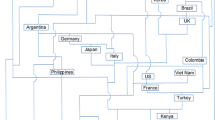Abstract
A distribution of a social variable over a population assigns a level or value of the variable to each individual in the population. The present paper continues a study of methods of ordering distributions of a social variable that was begun in an earlier paper. The earlier paper addressed issues of meaningfulness of evaluative comparisons and then examined several fundamental criteria for social evaluation. The present paper focuses on a variety of methods of ordering distributions. It begins with additive extensions of a Pareto principle and then looks at a number of distributional dominance relations, all of which are based on individuals' preferences. Ordering methods that may be only marginally related to individuals' preferences are discussed in the latter part of the paper.
Similar content being viewed by others
Bibliography
ArrowK. J.: 1973, ‘Some Ordinalist-Utilitarian Notes on Rawls' Theory of Justice’, Journal of Philosophy 70, 245–263.
AtkinsonA. B.: 1970, ‘On the Measurement of Inequality’, Journal of Economic Theory 2, 244–263.
BalinskiM. L. and YoungH. P.: 1977, ‘Apportionment Schemes and the Quota Method’, American Mathematical Monthly 84, 450–455 & 542.
BeachC. M.: 1977, ‘Cyclical Sensitivity of Aggregate Income Inequality’, Review of Economics and Statistics 59, 56–66.
ChipmanJ. S.: 1971, ‘Consumption Theory Without Transitive Indifference’, in J. S.Chipman, L.Hurwicz, M. K.Richter and H. F.Sonnenschein (eds.), Preferences, Utility, and Demand, Harcourt Brace Jovanovich, New York.
ChipmanJ. S.: 1974, ‘The Welfare Ranking of Pareto Distributions’, Journal of Economic Theory 9, 275–282.
DaltonH.: 1920, ‘The Measurement of the Inequality of Incomes’, Economic Journal 30, 348–361.
DasguptaP., SenA., and StarrettD.: 1973, ‘Notes on the Measurement of Inequality’, Journal of Economic Theory 6, 180–187.
d'AspremontC. and GeversL.: 1977, ‘Equity and the Informational Basis of Collective Choice’, Review of Economic Studies 44, 199–209.
Debreu, G.: 1960, ‘Topological Methods in Cardinal Utility Theory’, Mathematical Methods in the Social Sciences 1959, 16–26.
EltetöÖ. and FrigyesE.: 1968, ‘New Income Inequality Measures as Efficient Tools for Causal Analysis and Planning’, Econometrica 36, 383–396.
FishburnP. C.: 1964, Decision and Value Theory, Wiley, New York.
FishburnP. C.: 1970a, Utility Theory for Decision Making, Wiley, New York.
FishburnP. C.: 1970b, ‘Intransitive Indifference in Preference Theory: A Survey’, Operations Research 18, 207–228.
FishburnP. C.: 1974, ‘Lexicographic Orders, Utilities and Decision Rules: A Survey’, Management Science 20, 1442–1471.
FishburnP. C.: 1975, ‘Axioms for Lexicographic Preferences’, Review of Economic Studies 42, 415–419.
FishburnP. C.: 1976a, ‘Evaluative Comparisons of Distributions of a Social Variable: Basic Issues and Criteria’, Social Indicators Research, 3, 143–179.
FishburnP. C.: 1976b, ‘Cardinal Utility: An Interpretive Essay’, International Review of Economics and Business 23, 1102–1114.
FishburnP. C.: 1976c, ‘Continua of Stochastic Dominance Relations for Bounded Probability Distributions’, Journal of Mathematical Economics 3, 295–311.
FishburnP. C.: 1978, ‘A Survey of Multiattribute/Multicriterion, Evaluation Theories’, in S.Zionts (ed.), Multiple Criteria Problem Solving, Springer-Verlag, New York.
GormanW. M.: 1968, ‘Symposium on Aggregation: The Structure of Utility Functions’, Review of Economic Studies 35, 367–390.
HammondP. J.: 1976, ‘Why Ethical Measures of Inequality Need Interpersonal Comparisons’, Theory and Decision 7, 263–274.
HochmanH. M. and RodgersJ. D.: 1969, ‘Pareto Optimal Redistribution’, American Economic Review 59, 542–557.
KakwaniN. C.: 1977, ‘Applications of Lorenz Curves in Economic Analysis’, Econometrica 45 719–727.
KolmS. Ch.: 1969, ‘The Optimal Production of Social Justice’, in Margolis and Guitton (eds.), Public Economics, Macmillan, New York.
KolmS. Ch.: 1976, ‘Unequal Equalities. I & II’, Journal of Economic Theory 12, 416–442; 13, 82-111.
LuceR. D.: 1973, ‘Three Axiom Systems for Additive Semiordered Structures’, SIAM Journal an Applied Mathematics 25, 41–53.
LuceR. D. and TukeyJ. W.: 1964, ‘Simultaneous Conjoint Measurement: A New Type of Fundamental Measurement’, Journal of Mathematical Psychology 1, 1–27.
MacCrimmonK. R.: 1973, ‘An Overview of Multiple Objective Decision Making’, in J. L.Cochrane and M.Zeleny (eds.), Multiple Criteria Decision Making, University of South Carolina Press, Columbia, South Carolina.
NewberyD.: 1970, ‘A Theorem on the Measurement of Inequality’, Journal of Economic Theory 2, 264–266.
PaglinM.: 1975, ‘The Measurement and Trend of Inequality: A Basic Revision’, American Economic Review 65, 598–609.
RawlsJ.: 1971, A Theory of Justice, Harvard University Press, Cambridge, Massachusetts.
RawlsJ.: 1974, ‘Concepts of Distributional Equity: Some Reasons for the Maximin Criterion’, American Economic Review 64, 141–146.
RothschildM. and StiglitzJ. E.: 1973, ‘Some Further Results on the Measurement of Inequality’, Journal of Economic Theory 6, 188–204.
RoyB.: 1971, ‘Problems and Methods with Multiple Objective Functions’, Mathematical Programming 1, 239–266.
SavageL. J.: 1972, 1954, The Foundations of Statistics, Dover Publications, New York; Wiley, New York.
SchutzR. R.: 1951, ‘On the Measurement of Income Inequality’, American Economic Review 41, 107–122.
ScottD.: 1964, ‘Measurement Structures and Linear Inequalities’, Journal of Mathematical Psychology 1, 233–247.
SenA. K.: 1970, Collective Choice and Social Welfare, Holden-Day, San Francisco.
SenA.: 1974, ‘Informational Bases of Alternative Welfare Approaches’, Journal of Public Economics 3, 387–403.
SenA.: 1976, ‘Welfare Inequalities and Rawlsian Axiomatics’, Theory and Decision 7, 243–262.
SheshinskiE.: 1972, ‘Relation Between a Social Welfare Function and the Gini Index of Income Inequality’, Journal of Economic Theory 4, 98–100.
SuppesP.: 1956, ‘The Role of Subjective Probability and Utility in Decision-Making’, Proceedings of the Third Berkeley Symposium on Mathematical Statistics and Probability, 1954–1955, 5, 61–73.
Author information
Authors and Affiliations
Rights and permissions
About this article
Cite this article
Fishburn, P.C. Evaluative comparisons of distributions of a social variable: Ordering methods. Soc Indic Res 6, 103–126 (1979). https://doi.org/10.1007/BF00305439
Issue Date:
DOI: https://doi.org/10.1007/BF00305439



